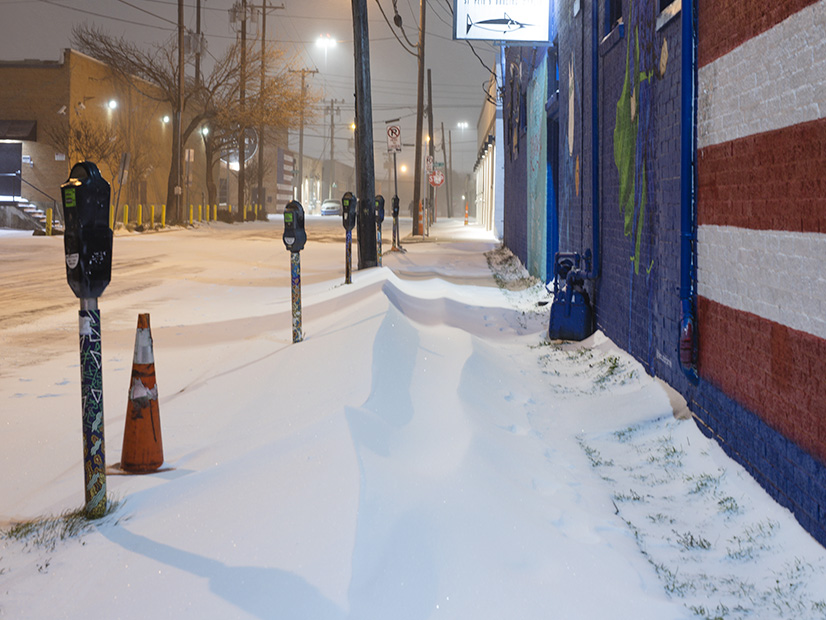
A snow-covered sidewalk in Deep Ellum, Texas, during the February 2021 winter storm.
| Matthew T. Rader, CC BY-SA 4.0, via Wikimedia CommonsFERC on Tuesday approved NERC’s proposed cold weather reliability standards in an order that both completes more than two years of work by the standards development team (SDT) for Project 2019-06 while also acknowledging the likelihood of further cold weather-focused standards development work (RD21-5).
The new standards consist of EOP-011-2 (Emergency preparedness and operations), IRO-010-4 (Reliability coordinator data specification and collection) and TOP-003-5 (Operational reliability data). All are revisions to existing standards, reflecting the SDT’s commitment to avoid overly sweeping changes in response to concerns raised by stakeholders in the project’s initial stages. (See Gen Operators Cool to Winter Preparedness Standard.)
Changes from EOP-011-1 include:
- the addition of two requirements, R7 and R8, mandating that generator owners (GOs) to implement a plan to protect their units from freezing “based on geographical location and plant configuration” and to provide maintenance and operating personnel with unit-specific training on the plan, respectively;
- the revision of requirements related to “the consideration of the reliability impacts of cold weather conditions in transmission operator [TOP] and balancing authority emergency operating plans”;
- changing the title of the standard, currently “Emergency operations”; and
- updating the purpose statement to add GOs as entities responsible for compliance with the standard.
IRO-010-4 and TOP-003-5 would require reliability coordinators, TOPs and BAs to include in their data specifications provisions for reporting the cold weather information identified by the GO in the cold weather plan.
FERC also accepted NERC’s 18-month implementation plan for each of the revised standards. The implementation timeline begins on the first day of the first calendar quarter following the date of approval; hence, the standards will take effect April 1, 2023.
“This implementation plan is reasonable to accommodate entities that may need time to perform various engineering analysis; provide the required training; and develop the necessary capabilities to satisfy revised data specifications,” FERC said in its order. “Nevertheless, we strongly encourage entities that are capable of complying with the cold weather reliability standards earlier than the mandatory and enforceable date to do so.”
The commission further encouraged NERC to pursue additional measures “to support reliability during the upcoming winter season” as well as the next, before the new standards become enforceable. Such measures are already underway: NERC last week issued a Level 2 alert “intended to evaluate the bulk electric system’s winter readiness.” (See NERC Issues Cold Weather Alert.)
Future Standards Actions Likely
NERC began Project 2019-06 in response to a joint report with FERC staff on the January 2018 cold weather event, when below-average temperatures resulted in 183 generating units in SPP, MISO, the Tennessee Valley Authority and SERC Reliability experiencing either an outage or a failure to start over a five-day period.
The project faced considerable industry skepticism in its early days. SDT members frequently fielded questions from utilities about whether such an initiative was even necessary. Respondents based in northern regions said they already know how to prepare for winter without mandatory standards, while those in more temperate climates wondered what was the point of preparing for cold weather that might never come.
February’s winter storms, which led to prolonged mass outages in Texas, lent urgency to the effort. (See ERCOT: Grid was ‘Seconds and Minutes’ from Total Collapse.) In the weeks following the cold snap, NERC’s Standards Committee authorized shortening the second formal ballot and commenting period from 45 days to 25 days in hopes of submitting the standards to the Board of Trustees for approval in June. (See NERC Cold Weather Team to Seek Faster Finish.)
Even as they authorized accelerating development of these standards, NERC has made clear that more, new standards relating to cold weather preparedness are all but certain. In a media roundtable in April, CEO Jim Robb referred to “the standards as currently conceived” as a “basic framework” that will need “amendments or adjustments” in the future. (See NERC Provides Cold Weather, Cyber Updates.)
Future standards development work could arise in response to the joint inquiry on February’s storms that FERC and NERC announced just days after the crisis peaked. (See “FERC, NERC Announce Joint Inquiry,” Slow Storm Restoration Sparks Anger in Texas, South.) The report is expected to be completed by the end of the year.



